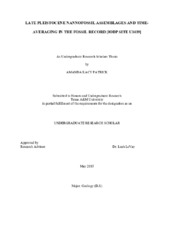| dc.creator | Patrick, Amanda Kacy | |
| dc.date.accessioned | 2015-06-30T14:02:58Z | |
| dc.date.available | 2015-06-30T14:02:58Z | |
| dc.date.created | 2015-05 | |
| dc.date.issued | 2014-09-21 | |
| dc.date.submitted | May 2015 | |
| dc.identifier.uri | https://hdl.handle.net/1969.1/154534 | |
| dc.description.abstract | When looking at geologically rapid climatic changes, such as glacial/interglacial cycles, the true response of organisms may be obscured in the fossil record due to time averaging. Time averaging can also impact the rates of origination and speciation in the fossil record. Integrated Ocean Drilling Program (IODP) Site U1419 was cored in the Gulf of Alaska in 2013. It yielded a Late Pleistocene-Holocene sedimentary section with high sedimentation rates on the order of 1cm/year. The nannofossil assemblage at 1cm resolution across a glacial/interglacial boundary to determine (1) the yearly variability of the nannofossil assemblage and (2) changes in the nannofossil assemblage related to environmental forces across this transition. I will then use statistical methods to model how much variability in the assemblage would be lost due to time averaging on different time scales. The result of information loss due to time averaging could help to evaluate fossil records from areas with highly time averaged section. | en |
| dc.format.mimetype | application/pdf | |
| dc.subject | Nannofossils, Pleistocene, Time averaging | en |
| dc.title | Late Pleistocene Nannofossil Assemblages and Time-Averaging in the Fossil Record [IODP Site U1419] | en |
| dc.type | Thesis | en |
| thesis.degree.department | Geology and Geophysics | en |
| thesis.degree.discipline | Geology | en |
| thesis.degree.grantor | Honors and Undergraduate Research | en |
| dc.contributor.committeeMember | LeVay, Leah | |
| dc.type.material | text | en |
| dc.date.updated | 2015-06-30T14:02:58Z | |


